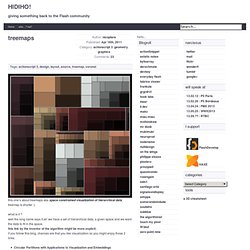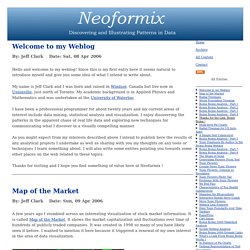

Nicolas Barradeau (nicoptere) sur Twitter. Treemaps « HIDIHO! This one’s about treemaps aka space constrained visualization of hierarchical data. treemap is shorter :) what is it ?

Well the long name says it all: we have a set of hierarchical data, a given space and we want the data to fit in the space.this link by the inventor of the algorithm might be more explicit. if you follow this blog, chances are that you like visualization so you might enjoy those 2 links: this algorithm ( described here ) is used in many feed aggregators (Flipboard for instance), some online newspapers and – at an experimental state – for data visualization. partly because the results are not 100% reliable when dealing with lots of items, mostly because it is a pain to code. still it’s a fascinating way to organize a layout given a weighted pool of things. initially, I had to find an original layout for a shitload of items. the items ( pictures, videos and texts ) would have to cover the biggest possible area of the screen. that’s where I heard about treemaps and all.
Treemap 4.0 Demo. Discovering and Illustrating Patterns in Data. Welcome to my Weblog By: Jeff Clark Date: Sat, 08 Apr 2006 Hello and welcome to my weblog!

Since this is my first entry here it seems natural to introduce myself and give you some idea of what I intend to write about. My name is Jeff Clark and I was born and raised in Windsor, Canada but live now in Unionville, just north of Toronto. My academic background is in Applied Physics and Mathematics and was undertaken at the University of Waterloo. I have been a professional programmer for about twenty years and my current areas of interest include data mining, statistical analysis and visualization. As you might expect from my interests described above I intend to publish here the results of any analytical projects I undertake as well as sharing with you my thoughts on any tools or techniques I learn something about.
Thanks for visiting and I hope you find something of value here at Neoformix ! Map of the Market By: Jeff Clark Date: Sun, 09 Apr 2006 Radial Treemaps World Population Treemap 1. 2. Squarified Treemaps with source !! Treemaps (sometimes called heatmaps) are one of my favorite data visualization techniques, and it has taken me a while to finally figure out how to do them.

The idea is simple: Each component is represented by a rectangle whose area is proportional to the ‘weight’ or relative importance of the item. I finally did find a technical paper on the idea and have implemented it in my source code. The algorithm efficiently finds what the best dimensions should be for the rectangle keeping its length-to-width ratio as close to one as possible.
The demo application reads Digg’s music news feed and draws rectangled based on the number of diggs each entry got. To really play with the application, resize the container and see the application redraw itself to respond to the change in dimensions. The code is released under the MIT liscense, so feel free to use it. The DiggReader application can be seen here and the source can be seen here. [Update: The latest version of the library is now on GitHub. Src/com/arpitonline at master from arpit/treemaps - GitHub. David Wynne's Blog : Silverlight Treemap Algorithm. I recently had a requirement to deal with displaying groups of dynamic data in Silverlight.

The data will come in a variable number of groups, with a variable number of items in each group. In order to display all items correctly, groups that have more items in require more screen real estate than those with less items. Whilst thinking through how I might spilt up the available screen space in that manner, it occurred to me that what I was essentially trying to create was a Treemap. Generally speaking, a treemap is a type of graph - filling a given area with rectangles that vary in size to represent their relative value.
Whilst doing some research into how treemaps are constructed I came across an old article on Code Project from 2004 where a chap had taken a somewhat obscure mathematical paper on a Squarified Treemap Algorithm from a Dutch University and created a C# implementation to run on Longhorn (this was 2004).